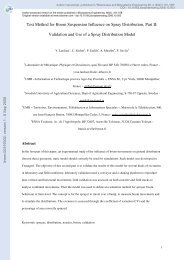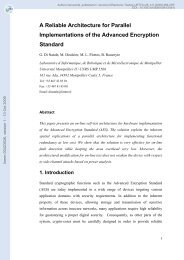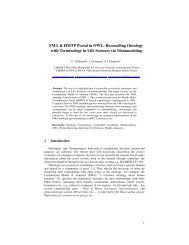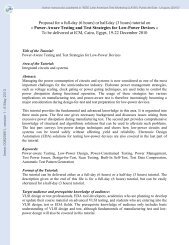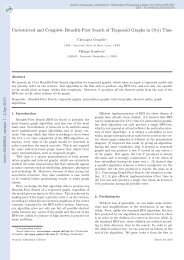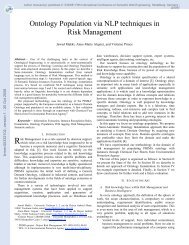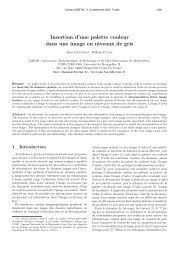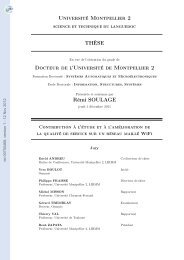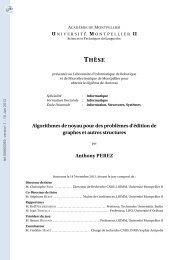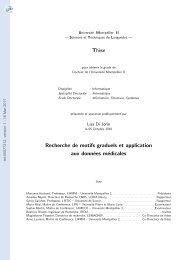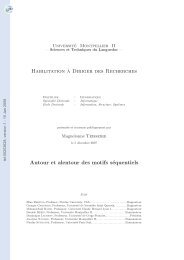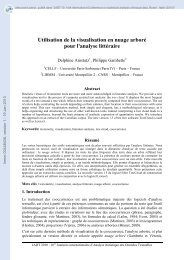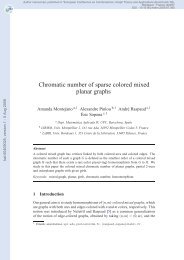A guaranteed obstacle avoidance guidance system: The safe ...
A guaranteed obstacle avoidance guidance system: The safe ...
A guaranteed obstacle avoidance guidance system: The safe ...
You also want an ePaper? Increase the reach of your titles
YUMPU automatically turns print PDFs into web optimized ePapers that Google loves.
hal-00733826, version 1 - 19 Sep 2012<br />
Auton Robot (2012) 32:177–187 181<br />
serving convergence properties as the following functions<br />
are considered in the algorithm:<br />
– Path following<br />
– Actuation saturation constraint<br />
– Obstacle <strong>avoidance</strong><br />
3.1 Path-following control design<br />
<strong>The</strong> solution to the problem of path following admits an intuitive<br />
explanation: a path following controller should look<br />
at (i) the distance from the vehicle to the path and (ii) the<br />
angle between the vehicle velocity vector and the tangent to<br />
the path, and reduce both to zero. This motivates the development<br />
of the kinematic model of the vehicle in terms of<br />
a Serret-Frenet frame {F } that moves along the path; {F }<br />
plays the role of the body axis of a path following target<br />
that should be tracked by the vehicle. Using this set-up, the<br />
abovementioned distance and angle become the coordinates<br />
of the error space (s1,y1,θ) where the control problem is<br />
formulated and solved, as expressed in (3).<br />
Motivated by the work in Micaelli and Samson (1992),<br />
the Serret-Frenet frame {F } that moves along the path to be<br />
followed is used with a significant difference: {F } is not attached<br />
to the point on the path that is closest to the vehicle.<br />
Instead, the origin of {F } along the path is made to evolve<br />
according to a conveniently defined function of time, effectively<br />
yielding an extra controller design parameter. As it<br />
will be seen, this seemingly simple procedure allows to lift<br />
the stringent initial condition constraints that arise with the<br />
path following controller described in Micaelli and Samson<br />
(1992), effectively warranting a global solution, i.e. whatever<br />
the initial conditions.<br />
Equipped with the previously defined formalism, the<br />
problem under study is to design a kinematic control law,<br />
in terms of [wleft,wright, ˙s] that asymptotically drives a single<br />
unicycle robot to the path, with a desired arbitrary forward<br />
velocity profile ud. We introduce the approach angle<br />
δ := −θA tanh (kδy1), where kδ is an arbitrary positive gain,<br />
and θA defines the asymptotic desired approach, which defines<br />
the approach angle when |y1| is huge. Traditionally,<br />
θA = π/2, which implies that the <strong>system</strong> is driven to the<br />
path with a relative incidence of π/2, i.e. perpendicular to<br />
the path. <strong>The</strong>n, as shown in Lapierre et al. (2006), the following<br />
control law solves the path following problem<br />
wleft = (ud − LrPF)/R,<br />
wright = (ud + LrPF)/R,<br />
˙s = u cos θ + Kss1<br />
where<br />
rPF := ˙δ − K1(θ − δ) + c˙s (5)<br />
and K1 and Ks are arbitrary positive gains.<br />
(4)<br />
This solution is Globally Exponentially Convergent<br />
(GEC) and provides a useful decoupling between the heading<br />
and the forward velocity controllers. <strong>The</strong> reader is invited<br />
to refer to Lapierre et al. (2006) for complete proof,<br />
extension to dynamics and robustness.<br />
Note that the <strong>guidance</strong> objective for path following is<br />
achieved when θ −δ = 0, or equivalently when ψ = ψF +δ.<br />
We introduce the global path following heading reference:<br />
ψPF := ψF + δ. (6)<br />
3.2 Inclusion of actuation saturation constraint<br />
<strong>The</strong> consideration of actuation constraint, within the previous<br />
path following strategy, has been treated in Lapierre and<br />
Indiverri (2007). It consists in adapting the current forward<br />
velocity reference according to the following constraint:<br />
<br />
(w2 max − w2 left )>0,<br />
(w2 max − w2 right )>0<br />
∀t. (7)<br />
Proposition 1 <strong>The</strong> path following requirement, under actuation<br />
saturation constraint, is achieved using the following<br />
kinematic control:<br />
rPF = fr + gruPF<br />
(8)<br />
where<br />
fr =−k3tanh(θ − δ) + k4(.)s1c[1 − s1δ ′ ],<br />
uPF = ud Rwmax − L(1/4 + f<br />
umax<br />
2<br />
r )<br />
1 + L(1/4 + g2 r )<br />
,<br />
gr = c cos θ(1 − s1δ ′ ) + δ ′ sin θ,<br />
δ ′ = ∂δ<br />
(9)<br />
∂y1<br />
where k4(.) :=<br />
tive, respecting the following conditions:<br />
k3 + kk<br />
2<br />
< R<br />
L wmax,<br />
umax := Rwmax − L/4<br />
,<br />
1 + L/4<br />
wmax >L/4R,<br />
ud ≤ umax.<br />
kk<br />
1+[s1cc(1−s1δ ′ )] 2 , k3 and kk are chosen posi-<br />
(10)<br />
Finally, the wheel velocity control is obtained with:<br />
wleft = (uPF − LrPF)/R,<br />
wright = (uPF + LrPF)/R,<br />
(11)<br />
˙s = uPF cos θ + kss1.<br />
Note that u PF = ud is achieved when the yaw control<br />
rPF = 0. Moreover, since the surge control uPF can be<br />
reduced to zero in case of a strong yaw control (rPF =<br />
R L wmax), any continuous path is followable, for any value



